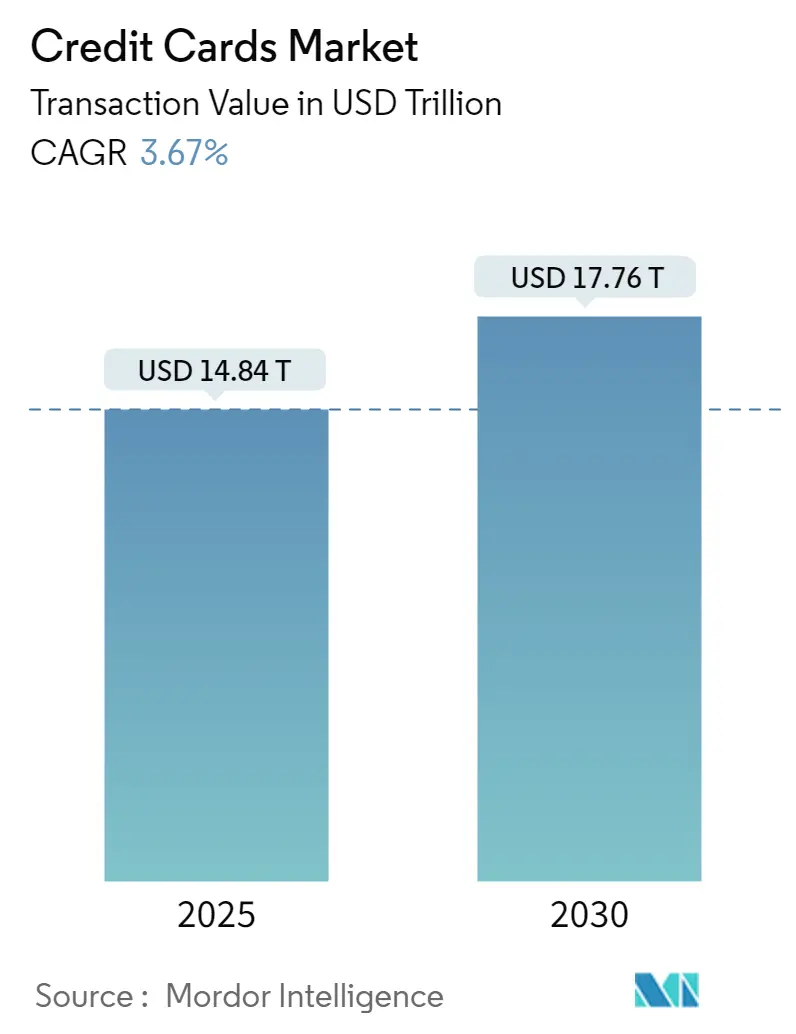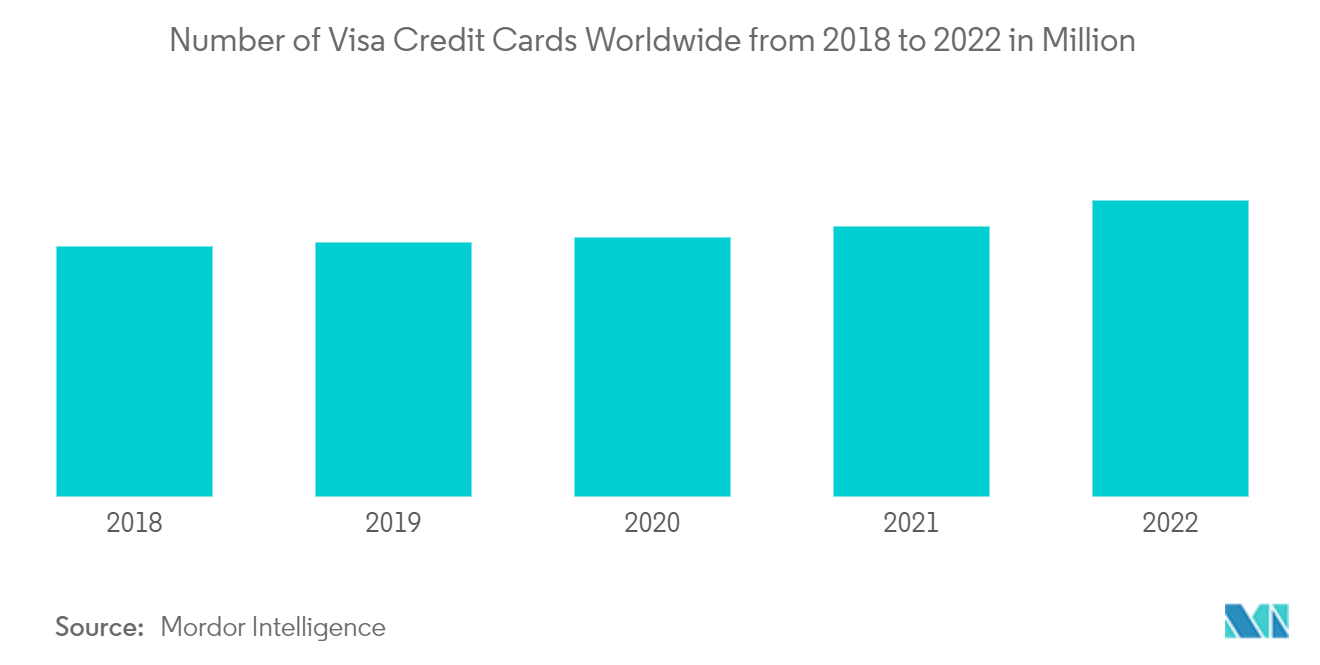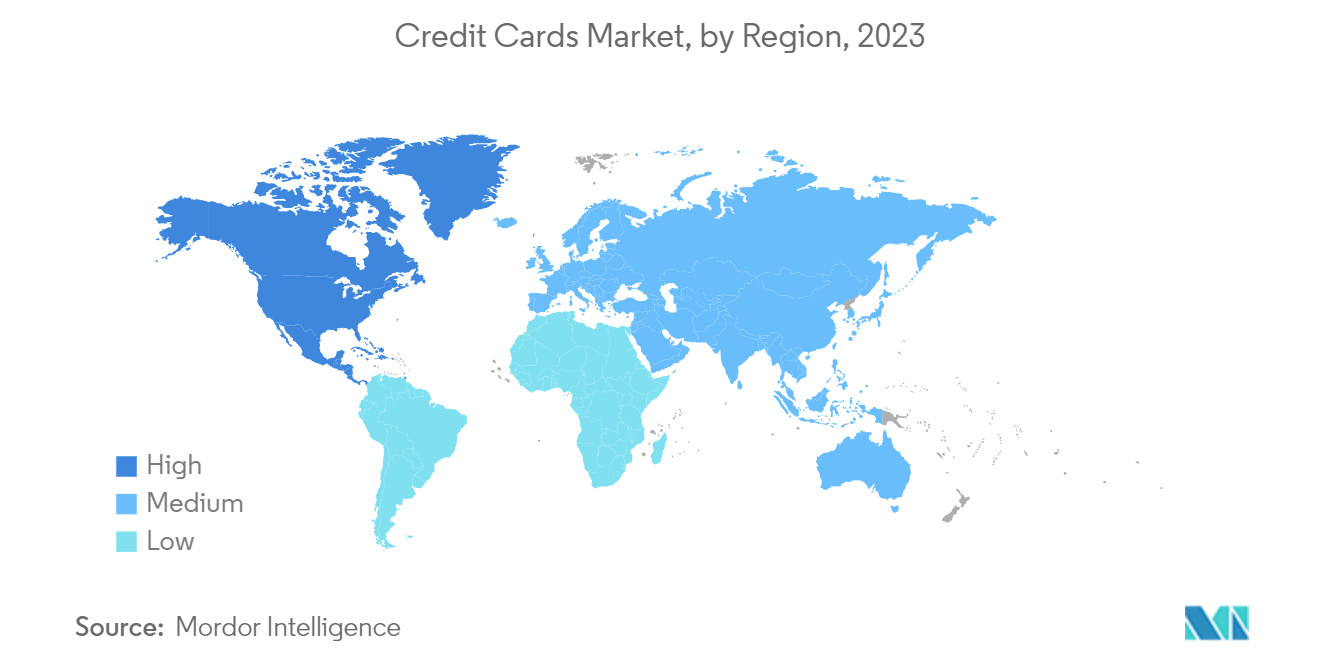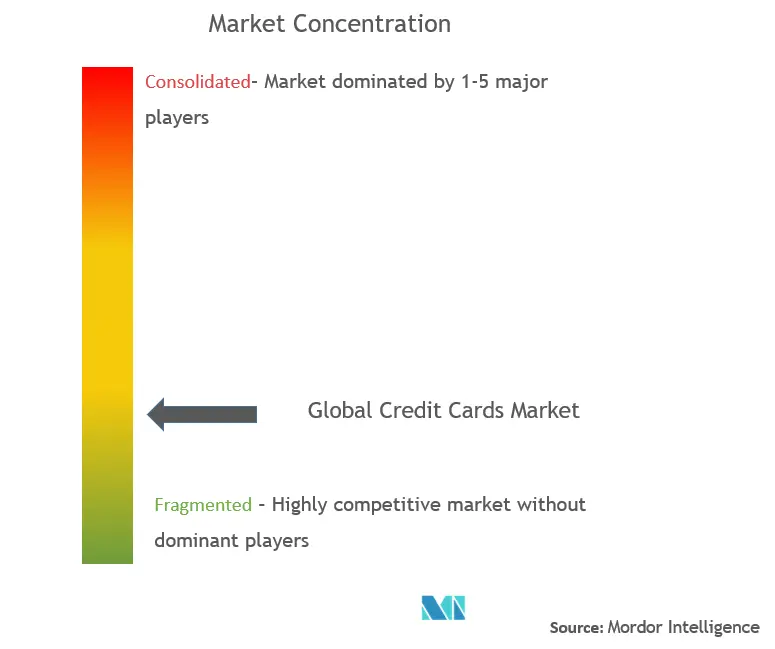Credit Cards Market Analysis
The Credit Cards Market size in terms of transaction value is expected to grow from USD 14.84 trillion in 2025 to USD 17.76 trillion by 2030, at a CAGR of 3.67% during the forecast period (2025-2030).
Credit cards are a part of everyday life. The average credit card debt per borrower was USD 5,474 or about USD 617 higher than the year before. This shift may be due to inflation and marks a move in the wrong direction. Collectively, this adds up to USD 38 billion in new debt in a single quarter and represents a 15% increase year-over-year, and this is the largest change in two decades. In two decades, the percentage of transactions made by credit cards is higher for households with higher incomes. It jumps to 34% for households earning USD 100 million to USD 150 million and 44% for those earning over USD 150 million.
There is a similar trend when considering educational status and credit usage. 96% of college graduates hold a credit card, while only 52% still need to complete high school. Asian Americans (93%) and Caucasian Americans (88%) were the most likely demographic groups to hold credit cards. The average credit card interest rate is 24.08%, according to Forbes Advisor's credit card rate report as of mid-March 2023.
Paying off credit card bills in full every month is always the best course of action, but when that's not possible, it's still important to make the minimum payment. You can avoid a delinquent mark on your credit report and several credit card fees by making the minimum payment. Having a strong credit rating can help you qualify for the best credit cards and the most competitive rates for mortgages, auto loans, and other lending products.
Pre-pandemic payments as a percentage of the total balance were stable and followed normal seasonal trends. In the initial stages of the pandemic, this fell as delinquency increased due to government support or stimulus packages being set up and implemented. Once these were in place, rates started to rise with the usual fluctuation.
Credit Cards Market Trends
Increasing Number of Visa Credit Cards Internationally
The number of cards gives a crude idea of market saturation. Visa is a prominent processing network, and its cards are accepted by businesses in more than 200 countries and territories around the world. Visa cards are payment cards that use the Visa network. Financial institutions partner with Visa to use the company's network. Visa cards come with a 16-digit account number, a microchip, and a magnetic stripe. Types of Visa cards include credit cards, debit cards, prepaid cards, and gift cards. Other payment processing companies with ownership of payment processing networks include Mastercard, American Express, and Discover. Visa credit cards give you the convenience and security to make purchases, pay bills, or get cash from over 2 million ATMs worldwide.
North America Commands a Dominant Position in the Global Credit Card Market
The United States, within North America, commands a dominant position in the global credit card market, bolstered by several key factors. Firstly, the nation boasts a highly developed financial infrastructure and a mature credit card industry. This industry is characterized by an extensive network of credit card issuers, payment processors, and financial institutions. Notably, major credit card networks like Visa, Mastercard, American Express, and Discover have their headquarters in the United States, further solidifying its global leadership.
Secondly, credit card usage is deeply ingrained in consumer spending habits, particularly in the United States. The widespread acceptance of credit cards for everyday purchases, spanning retail, dining, travel, and online shopping, contributes to the region's robust credit card penetration. Moreover, the prevalent culture of rewards and incentives tied to credit card usage, such as cashback, travel perks, and loyalty programs, further fuels consumer preference for credit cards.
Additionally, North America's prominence in e-commerce and digital payments significantly propels the credit card market's growth. The United States, in particular, boasts a mature e-commerce landscape, with a sizable population relying on credit cards for secure and seamless online transactions.
Credit Cards Industry Overview
The global credit cards market is highly competitive and fragmented, as various international and regional vendors provide new technology. The key players are emerging to improve their products and delivery through techniques and enhance their products to have a competitive edge over others.
Furthermore, the companies are involved in acquisitions and expansions to improve their product offerings. The report highlights the numerous strategic initiatives, such as new business deals and collaborations, mergers and acquisitions, joint ventures, product launches, and technological upgrades, implemented by the leading market contenders to set a firm foot in the market. Hence, this section includes the company profiles of the key players and industry analysis. American Express, Banco Ita, Bank of America Merrill Lynch, Bank of Brazil, and Bank of East Asia offer the global credit card market.
Credit Cards Market Leaders
-
American Express
-
Banco Itaú
-
Bank of America Merrill Lynch
-
Bank of Brazil
-
Bank of East Asia
- *Disclaimer: Major Players sorted in no particular order
Credit Cards Market News
- May 2023: Singapore's DBS Bank looks to complete its retail product offering by adding a super-premium credit card as soon as this week as it seeks to consolidate its position two-and-a-half years after acquiring Lakshmi Vilas Bank (LVB).
- May 2023: NPCI leans on bank partnerships to push RuPay credit cards.
Credit Cards Industry Segmentation
A complete background analysis of the credit card market, which includes an assessment of the economy, market overview, market size estimation for key segments, emerging trends in the market, market dynamics, and key company profiles, is covered in the report.
The credit card market is segmented by card type. By card type, the market is sub-segmented into general-purpose credit cards and specialty and other credit cards. By application, the market is sub-segmented into food and groceries, health and pharmacy, restaurants, and bars, consumer electronics, media and entertainment, travel and tourism, and other applications. By provider, the market is sub-segmented into visa, mastercard, and others, and by geography, the market is sub-segmented into North America, Europe, Asia-Pacific, Latin America, the Middle East, and Africa.
The report offers market size and forecasts for the credit card market in value (USD) for all the above segments.
| By Card Type | General Purpose Credit Cards | ||
| Specialty & Other Credit Cards | |||
| By Application | Food & Groceries | ||
| Health & Pharmacy | |||
| Restaurants & Bars | |||
| Consumer Electronics | |||
| Media & Entertainment | |||
| Travel & Tourism | |||
| Other Applications | |||
| By Provider | Visa | ||
| MasterCard | |||
| Other Providers | |||
| By Geography | North America | United States | |
| Canada | |||
| Rest of North America | |||
| Europe | UK | ||
| Germany | |||
| France | |||
| Italy | |||
| Netherlands | |||
| Rest of Europe | |||
| Asia-Pacific | China | ||
| Japan | |||
| India | |||
| Australia | |||
| Singapore | |||
| South Korea | |||
| Rest of Asia-Pacific | |||
| Middle East & Africa | Saudi Arabia | ||
| Egypt | |||
| UAE | |||
| Rest of Middle East and Africa | |||
Credit Cards Market Research Faqs
How big is the Credit Cards Market?
The Credit Cards Market size is expected to reach USD 14.84 trillion in 2025 and grow at a CAGR of 3.67% to reach USD 17.76 trillion by 2030.
What is the current Credit Cards Market size?
In 2025, the Credit Cards Market size is expected to reach USD 14.84 trillion.
Who are the key players in Credit Cards Market?
American Express, Banco Itaú, Bank of America Merrill Lynch, Bank of Brazil and Bank of East Asia are the major companies operating in the Credit Cards Market.
Which is the fastest growing region in Credit Cards Market?
Asia Pacific is estimated to grow at the highest CAGR over the forecast period (2025-2030).
What years does this Credit Cards Market cover, and what was the market size in 2024?
In 2024, the Credit Cards Market size was estimated at USD 14.30 trillion. The report covers the Credit Cards Market historical market size for years: 2020, 2021, 2022, 2023 and 2024. The report also forecasts the Credit Cards Market size for years: 2025, 2026, 2027, 2028, 2029 and 2030.
Our Best Selling Reports
Credit Cards Industry Report
The global credit card market is experiencing robust growth, driven by the increasing demand for cash alternatives and the availability of affordable credit cards. Dominated by general-purpose credit cards due to their versatility and rewards, the market also sees rising interest in specialty credit cards, which offer higher limits and benefits tailored to specific organizational needs. North America currently leads in market share, due to major banking service providers, while Asia-Pacific is expected to see significant growth due to favorable demographic shifts and rising income levels. Technological advancements like blockchain integration promise enhanced security and lucrative market expansion opportunities. Additionally, the surge in digital payments, supported by government initiatives for digital financial inclusion, contributes to market dynamics. However, the prevalence of credit card fraud remains a substantial risk. As the market trends towards digital and contactless payment methods, it continues to expand, fueled by ongoing innovation and evolving consumer preferences. For a detailed forecast and historical overview of the credit card market, consider accessing industry reports from Mordor Intelligence™, which provide comprehensive market analysis and projections. This analysis is crucial for understanding trends in the credit card industry and assessing credit card market share. Get a sample of this industry analysis as a free report PDF download.







